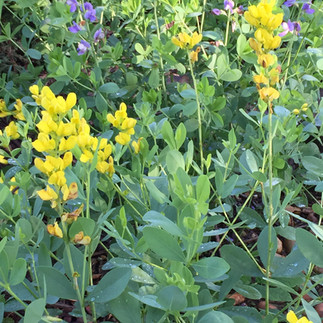This perennial does it all.

Wild blue indigo (Baptisia australis) is a terrific cut flower, an incredible foliage plant, requires no maintenance and produces some of our most beautiful native flowers, typically in May. Every year, one of the producers at my local farmers market sells wild indigo by the arm loads and it is easy to see why. As cut flowers, they practically arrange themselves in a graceful shape and last for well over a week with frequent water changes.
This flower was the first native plant that really caught my attention. Back when the visionary leaders of Adkins Arboretum were beginning the hard work to grow the hidden gem into the native plant mecca it is today, the Arboretum had wild blue indigo planted at the entrance, in the median between the entrance and exit lanes. As I recall, it was just wild blue indigo in full sun and, in bloom, it was this wave of vibrant blue signaling something special. I was totally intrigued and my native plant interest began in earnest.
I recently recommended wild blue indigo as a perfect flower to fill the flower gap that can occur between the bounty of spring and the arrival of summer. Noted garden designer Barbara Katz, founder of London Landscapes, commented that not everyone has room for the straight species in their garden and suggested dwarf wild indigo (Baptisia australis var. minor) for space constrained gardens. Please check out this post about her stunning garden. When Barbara offers suggestions, I listen!
Around the same time, my friend Robert texted me about his latest plans to corral the five straight species wild blue indigo he has growing in full sun. He sends me photos of these most years because they are living their best life. They get really, really large. All of this got me to thinking, I need to know more about wild blue indigo!
Growing:
Wild indigo needs full sun to bloom profusely. It easily tolerates clay soil and is drought tolerant once established. Give it time to get well established which can take several years. Wild indigo has a long bloom period, usually two to three weeks.
Moving this plant successfully, once it is established, is extremely difficult. It grows a deep tap root system and moving it inevitably severs the roots too severely. Place plants five to eight feet part to give them room to mature. Plant in locations that will not eventually become shaded.
I have tried growing wild blue indigo from plugs and they grow very, very slowly. This is a plant I would buy in the gallon size or quart at the smallest. If your experience has differed, please do share.
Growing Habits:
The only downside to these fantastic plants I know of is some tend to flop after the blooms fade. Seeds and plants vary. Not all the plants flop. Some of them do. If you grow the straight species, as I do, you may find that some are sturdy like mine or some may flop like my friend Robert's. If this is a concern for you, check out the recommendations from the Mt. Cuba Center below.
As for Robert, after trying to support his five wild blue indigo plants with traditional concentric ring supports, he landed on a new idea inspired by gardener Jamie's (Growing Native in Maryland) amazing front yard garden!
Varieties of Wild Indigo
Wild Blue Indigo
Wild blue indigo, (Baptisia australis), is the straight species with blue flowers. It typically grows four feet high and up to eight feet wide when mature. Depending on the particular plant, it may flop after blooming. It produces black seed pods in fall.
Dwarf Wild Indigo
Dwarf wild indigo (Baptisia australis var. minor) is a smaller species with the same blue flowers and black seed pods. It grows to three feet tall and is known to be sturdier and less likely to flop. Dwarf wild indigo is available by mail from Putnam Hill Nursery and Plant More Natives.
Yellow Wild Indigo
Yellow wild indigo (Baptisia tinctoria) is the straight species with yellow flowers. Mt. Cuba does not recommend this variety for showy flower wands because the flowers are more sporadic than wild blue indigo.
White Wild Indigo
White wild indigo (Baptisia alba) is the straight species with white flowers. The plant grows about three feet high and about four feet wide.
Cultivars of Wild Indigo
There are a number of cultivars of wild indigo. Some cultivars are grown to create sturdier plants, some for more flower wands and others for different flower colors. A Mt. Cuba Center trial of baptisia ending in 2015 evaluated the plants for all three of these traits as well as length of flowering. Here are Mt. Cuba's top ten:
Gotta love those names! Plant More Natives has a number of these cultivars and straight species available. Whether you choose the straight species or one of these cultivars, or several of both, these are some gorgeous May flowers with long lasting foliage to follow.
Here, a cultivar of wild indigo is thriving between a sidewalk and road in Washington D.C. where construction is occurring. Construction crews are not deterring pollinators. Pollinators have work to do too. Pretty amazing for a plant that naturally grows in forests and along stream banks.
As for that parking lot at Adkins Arboretum, the wild blue indigo was replaced long ago with a palette of plants indigenous to the Eastern Shore. It's the yellow wild indigo that is native to the Shore. That parking lot though has become a garden worthy of the trip on its own!
Happy Gardening.


























